A) marginal social cost curve lies below the marginal private cost curve.
B) marginal social benefit curve lies above the marginal private benefit curve.
C) equilibrium quantity in an unregulated, competitive market has a marginal social cost greater than the marginal social benefit.
D) equilibrium quantity in an unregulated, competitive market has a marginal social cost less than the marginal social benefit.
Correct Answer

verified
Correct Answer
verified
Multiple Choice
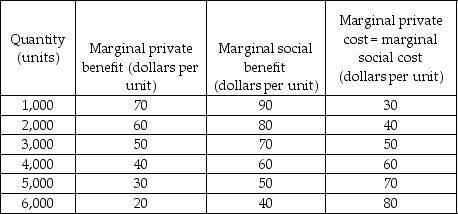 -In the above table, the efficient level of output is
-In the above table, the efficient level of output is
A) 2,000 units.
B) 3,000 units.
C) 4,000 units.
D) 5,000 units.
Correct Answer

verified
Correct Answer
verified
Multiple Choice
Consider a market in which there is an external cost. A tax can be used to arrive at the efficient market equilibrium because the tax will
A) decrease supply of the good.
B) increase supply of the good.
C) decrease demand for the good.
D) increase demand for the good.
Correct Answer

verified
Correct Answer
verified
Multiple Choice
The benefit from an additional unit of a good or service that the consumer of that good or service receives is the
A) marginal private benefit.
B) marginal external benefit.
C) marginal social benefit.
D) opportunity cost.
Correct Answer

verified
Correct Answer
verified
Multiple Choice
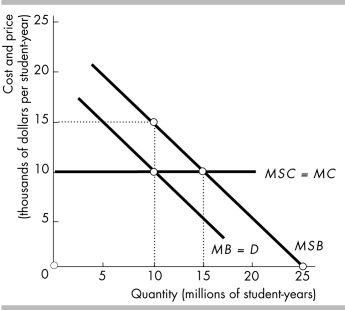 -The above figure shows the marginal benefits and marginal costs of a college education. If colleges receive a $5,000 subsidy, then enrollment equals
-The above figure shows the marginal benefits and marginal costs of a college education. If colleges receive a $5,000 subsidy, then enrollment equals
A) 0.
B) 10 million.
C) 15 million.
D) 25 million.
Correct Answer

verified
Correct Answer
verified
Multiple Choice
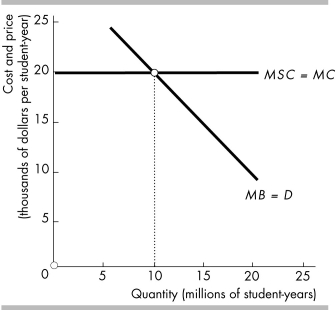 -The above figure shows the marginal private benefit and marginal social cost of a college education. A $10,000 subsidy to colleges results in a college charging tuition of
-The above figure shows the marginal private benefit and marginal social cost of a college education. A $10,000 subsidy to colleges results in a college charging tuition of
A) $0.
B) $10,000.
C) $20,000.
D) $30,000.
Correct Answer

verified
Correct Answer
verified
Multiple Choice
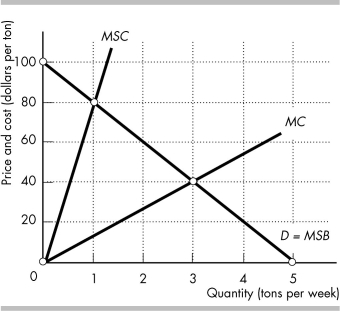 -The figure above provides information for a factory that produces chemicals that pollute a waterway. The waterway is used by water skiers. If the waterway is owned by a water ski club and the Coase theorem applies, then the factory will produce ________ tons of chemicals a week.
-The figure above provides information for a factory that produces chemicals that pollute a waterway. The waterway is used by water skiers. If the waterway is owned by a water ski club and the Coase theorem applies, then the factory will produce ________ tons of chemicals a week.
A) 1 ton
B) as many tons as possible
C) 3 tons
D) 5 tons
Correct Answer

verified
Correct Answer
verified
Multiple Choice
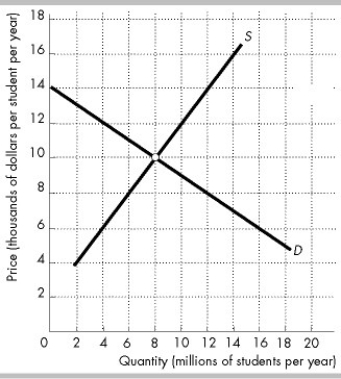 The figure shows the supply curve (S) and the demand curve (D) for college education. The external benefit from college education is $6,000 per student per year and is constant.
-In the figure above, with no government involvement and if the colleges are competitive, how many students are enrolled?
The figure shows the supply curve (S) and the demand curve (D) for college education. The external benefit from college education is $6,000 per student per year and is constant.
-In the figure above, with no government involvement and if the colleges are competitive, how many students are enrolled?
A) 8 million per year
B) 12 million per year
C) 10 million per year
D) 4 million per year
Correct Answer

verified
Correct Answer
verified
Multiple Choice
If the government assigns private property rights to a common resource, then the
A) resource is under-utilized.
B) marginal private cost becomes equal to the marginal social cost.
C) government needs to set a quota to achieve efficiency.
D) None of the above answers is correct.
Correct Answer

verified
Correct Answer
verified
Multiple Choice
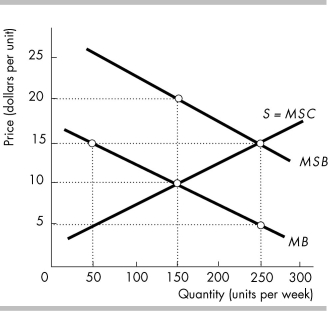 -In the above figure, if the market is competitive and unregulated
-In the above figure, if the market is competitive and unregulated
A) more than the efficient amount of output will be produced.
B) less than the efficient amount of output will be produced.
C) the efficient amount of output will be produced.
D) the distribution of income will be fair.
Correct Answer

verified
Correct Answer
verified
Multiple Choice
If production of a good produces an external benefit, in order for the marginal social cost to equal the marginal social benefit
A) the good should be taxed.
B) permits should be required to purchase the good.
C) the good could be subsidized.
D) the government needs to take no action.
Correct Answer

verified
Correct Answer
verified
Multiple Choice
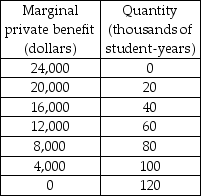 -The table above provides information about the marginal private benefit of education. The marginal private cost, which also equals the marginal social cost, of educating a student is $16,000 per year and does not change as more students are educated. There is an external benefit from education that is equal to $12,000 per student year and does not change as more students are educated. If the market for education is competitive and unregulated, the equilibrium quantity of education will be ________ and the tuition will be ________.
-The table above provides information about the marginal private benefit of education. The marginal private cost, which also equals the marginal social cost, of educating a student is $16,000 per year and does not change as more students are educated. There is an external benefit from education that is equal to $12,000 per student year and does not change as more students are educated. If the market for education is competitive and unregulated, the equilibrium quantity of education will be ________ and the tuition will be ________.
A) 20,000 student-years; $20,000
B) 40,000 student-years; $16,000
C) 60,000 student-years; $12,000
D) 80,000 student-years; $8,000
Correct Answer

verified
Correct Answer
verified
Multiple Choice
 -The above figure shows the marginal benefits and marginal costs of a college education. If no subsidies are paid, enrollment equals
-The above figure shows the marginal benefits and marginal costs of a college education. If no subsidies are paid, enrollment equals
A) 0.
B) 10 million.
C) 15 million.
D) 25 million.
Correct Answer

verified
Correct Answer
verified
Multiple Choice
The Coase theorem applies when property rights are given
A) to the victim of pollution but not to the polluter.
B) to the polluter but not to the victim.
C) to either the polluter or the victim.
D) neither to the polluter nor to the victim.
Correct Answer

verified
Correct Answer
verified
True/False
The marginal social cost is the cost of producing an additional unit of a good or service that falls on people other than the producer of the good or service.
Correct Answer

verified
Correct Answer
verified
Multiple Choice
 -In the above figure, if the market is competitive and unregulated, then at the equilibrium amount of output the marginal social benefit is
-In the above figure, if the market is competitive and unregulated, then at the equilibrium amount of output the marginal social benefit is
A) less than the marginal cost to producers.
B) greater than the marginal social cost.
C) equal to the marginal cost to producers.
D) equal to the marginal private benefit from consumption.
Correct Answer

verified
Correct Answer
verified
Multiple Choice
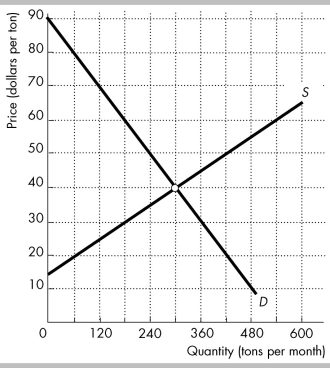 The figure shows the unregulated market for a pesticide, where S is the supply curve and D is the demand curve. The demand curve is the same as the MSB curve. When factories produce the pesticide, they also create waste, which they dump into a lake on the outskirts of the town. The marginal external cost of the dumped waste is equal to the marginal private cost of producing the pesticide.
-In the figure above, if no one owns the lake, what is the deadweight loss in the market?
The figure shows the unregulated market for a pesticide, where S is the supply curve and D is the demand curve. The demand curve is the same as the MSB curve. When factories produce the pesticide, they also create waste, which they dump into a lake on the outskirts of the town. The marginal external cost of the dumped waste is equal to the marginal private cost of producing the pesticide.
-In the figure above, if no one owns the lake, what is the deadweight loss in the market?
A) $2,400 per month
B) $1,800 per month
C) $3,600 per month
D) zero
Correct Answer

verified
Correct Answer
verified
Multiple Choice
When the production of a good creates an external cost, to achieve the efficient quantity governments can set taxes (T) such that
A) MSC = MC + T.
B) MC = MSC + T.
C) T = MC + MSC.
D) MSC = MC - T.
Correct Answer

verified
Correct Answer
verified
Multiple Choice
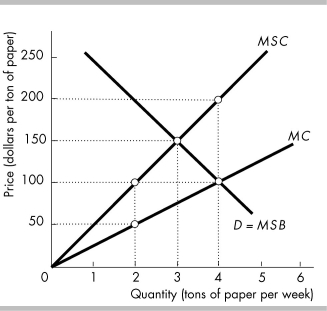 -The figure above shows the costs associated with producing paper. When paper is produced, there is some pollution runoff into a lake. According to the Coase Theorem, if the transactions costs are low and there are only a few people involved, the output will equal ________ tons of paper if ________ own the lake.
-The figure above shows the costs associated with producing paper. When paper is produced, there is some pollution runoff into a lake. According to the Coase Theorem, if the transactions costs are low and there are only a few people involved, the output will equal ________ tons of paper if ________ own the lake.
A) 3; only the lakeside residents
B) 3; either the firms or lakeside residents
C) 4; the firms
D) 4; either the firms or lakeside residents
Correct Answer

verified
Correct Answer
verified
Multiple Choice
The HPV vaccine protects against human papillomavirus (HPV) that causes cancer. It protects both the person getting the vaccine and the sexual partners of that person. In a private market with no government intervention, the equilibrium will be
A) overprovision of the HPV vaccine and a deadweight loss.
B) overprovision of the HPV vaccine but no deadweight loss.
C) underprovision of the HPV vaccine but no deadweight loss.
D) underprovision of the HPV vaccine and a deadweight loss.
Correct Answer

verified
Correct Answer
verified
Showing 101 - 120 of 437
Related Exams